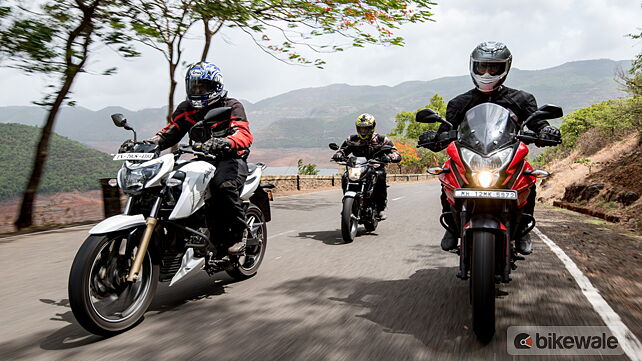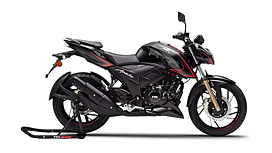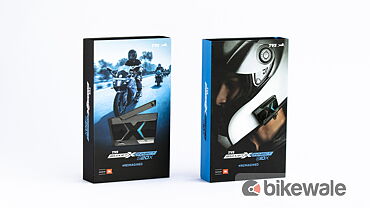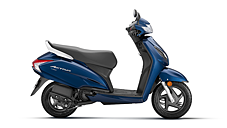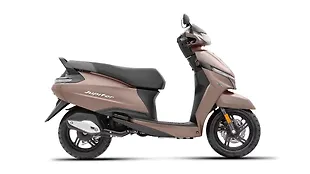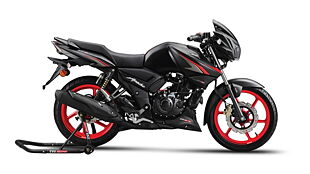Introduction

What we have here are two obvious players in the affordable and performance centric commuter class, and one outsider of sorts. The TVS Apache 200 4V – one of the obvious players, given it has nearly 20bhp – is the newest entrant. And though it is available both with fuel injection and carburetion, we have the latter for it is lesser priced.
Next up is the Bajaj Pulsar AS200. It is the second of the obvious players here for it too makes near 20bhp (23bhp to be precise). And, like the TVS, the AS200 is carburetted as well. However, the AS200 hasn’t found too many takers; it’s not a bike that’s selling well for Bajaj.
Finally, there’s the Honda Hornet 160R. And so far, it has done well on the sales front. It sits right on top of the 150cc, affordable (read non-faired) commuter pile and as you might have guessed, it is the outsider in this test.
And it is here to answer one crucial question –is it really worth spending more and buying a 200 when we have such capable 150s (and thereabouts) at lesser prices to choose from?
Let’s get right to it then…
Looks & Styling

We had mixed reactions here. I, personally, prefer the Hornet. It isn’t as dramatic as the TVS or as visually big as the AS200, but there’s something about its harmonious and flowing design that drew me to it. But like I said, we had mixed reactions and the majority went for the TVS Apache RTR 200. Fellow testers liked its edgy design, the sporty touches (like the offset tank filler) and the overall tight proportions that give the Apache 200 a racy, performance centric stance. 
The Pulsar AS200, typical of an adventure bike, is tall. It is essentially the same design as the Pulsar NS200, but the way the Bajaj designers have integrated that large half faring – it’s pretty seamless – it seems the AS was always the first thought. But, not everyone – possibly reflecting market sentiments – on the team liked the AS’s overall stance. TVS Apache RTR 200 then, wins the beauty round. 
Bajaj Pulsar AS200: 7/10
Honda Hornet 160R: 8/10
TVS Apache RTR 200: 8.5/10
Ergonomics & Quality

No clear winner here, however. But yes, the Bajaj AS200 could do with better fit and finish. Otherwise, all three bikes have good paint quality, and the touch points – levers, grips and switchgear – feel good to the touch and have acceptable levels of operability. 
In terms of ergonomics, the AS200 is the most upright. So, it feels comfortable while commuting, but thanks to its cramped seating, it doesn’t work that well on longer commutes. The Hornet 160R is a good compromise. It has low seat height, closer set footpegs and a handlebar that’s neither too high nor too far forward. It works well in the city, out on the highway and even around a set of corners. 
The Apache is more like the Hornet than the Pulsar. So, it has spacious seating but with a little better balance between comfort and aggression. And, the clip-on bars position, both in terms of height and reach, is better suited for a majority of Indian riders. Both the Apache and the Hornet have comfy seats too.
Bajaj Pulsar AS200: 7/10
Honda Hornet 160R: 8/10
TVS Apache RTR 200: 8/10
Features & Technology

The Hornet 160R brings up the rear here. In terms of features, there’s digital instrumentation with basic readouts like time, speed, rpm and a trip. It doesn’t even get an engine kill switch. The Apache 200 is better specced. It gets an engine kill switch and additionally, the all-digital console allows the rider to switch from kilometres to miles, alter the rpm for the shift light, and record top speed and 0-60kmph times. And like the Hornet and the Pulsar, the Apache too gets LED tail lamps and a single rear brake disc.
The Pulsar AS200 might not be as feature-rich as the Apache; even though it gets a backlit switchgear missing on the TVS. But, when it comes to technology the AS200 is the clear leader here. It gets everything the Apache has, and then it also gets liquid cooling and a projector headlamp. The latter is a real boon.
Bajaj Pulsar AS200: 6.5/10
Honda Hornet 160R: 5/10
TVS Apache RTR 200: 6/10
Engine & Performance

We always knew with a near 40cc deficit and a 4bhp (nearly 7bhp incase of the AS200) lower power figure, the Honda Hornet 160R was going to find it hard keeping up with the TVS and the Bajaj. And it does. More so if there’s a climb involved. The Hornet is the slowest to hit 60kmph from a standstill while the Apache 200 and the Pulsar AS200 remain pretty close with the TVS having a slight edge. It’s the same story in the top speed stakes with the Hornet struggling past 110kmph and the Apache 200 and the AS200 managing close to 130kmph.
But, here’s the thing; in the city, the Hornet has enough grunt to keep the other two in its sights. Even on the highway, at a sane cruising speed of around 100kmph, the Honda is very much at home. To add, the Hornet has the most refined engine and one with the least vibrations. So, keeping it pinned for long durations isn’t a bother at all.
The Pulsar AS200 for all its power and the ‘adventure’ tag, is the least fun on long rides. The engine lacks refinement and it is the most vibey in this bunch. Plus, it sounds crude. Settle in at 100kmph and you’ll end up with buzzing hands and feet a lot sooner than on the other two. As crazy as it might sound, we’d pick the slower but calmer Hornet over the AS200 if we were to ride extensively every day. 
But, of course, we won’t. For we have the Apache RTR 200. It’s not as relentless as the AS200 when it comes to top end performance, but it is way smoother. And it has enough grunt to help you overtake from even the magical 100kmph mark without bother. Be it in the city, cruising on the highway or even tackling a hill climb, when it comes to engines, the Apache has it covered.
Bajaj Pulsar AS200: 6.5/10
Honda Hornet 160R: 6/10
TVS Apache RTR 200: 7/10
Ride, Handling & Braking
The Apache RTR 200 also has it covered when it comes to ride and handling. The Apache’s ride is supple and absorbent; it barely weaves over bad roads; and even if you miss a speed breaker and land poorly thereafter, it never feels scary or unstable. The Hornet 160R, though not as supple as the TVS, still rides well. It’s a little firm, but it rarely bottoms out or feels skittish. Pot holes, bumpy roads, undulations and what have you, it feels like a bigger motorcycle similar to the TVS. 
Now, the Pulsar AS200 might bring up the rear here, but it’s not a bad riding motorcycle. It has a plush edge to its ride, and slow speeds, over broken tarmac, the Pulsar feels fine. However, bring in speed and deeper potholes into the picture, and its front end bottoms out quite badly. So much so, that you end up feeling you’d break something if this continues.
We won’t pick the Pulsar AS200 on a winding road either. It is a tall bike and its front end seems too far away to actually lend any decent feedback. Thanks to its handlebar positioning, it works well during a quick lane change, but when you want to tip it in deeper into corners, it feels vague and disconnected. The riding position doesn’t help here, neither do the tyres. And it simply doesn’t like quick direction changes. 
The Hornet in comparison feels light and agile and easy to throw around. We aren’t fans of the Hornet’s tyres either, but with more feedback via the front end and the chassis compared to the Pulsar, and of course quicker, more stable and predictable turn-in, the Hornet is way more enjoyable on twisty roads. 
But, it’s the Apache that’s the most fun. Like the Honda, the TVS is sharp and willing around bends. It’s also the richest in terms of feedback especially when leaned over. The optional Pirellis work superbly and the Apache just loves the quick direction transitions. If the Apache has one flaw in the dynamic department, it is the brakes. The TVS has the worst set here be it in terms of bite, feel or progression. The Honda with its CBS system comes out on top here.
Bajaj Pulsar AS200: 6/10
Honda Hornet 160R: 7/10
TVS Apache RTR 200: 7/10
Fuel Efficiency
No prizes for guessing which is the most fuel efficient bike here. But, it is the almost 10kmpl advantage that the Hornet pulls over the Apache (the least efficient bike in this test) that did take us by surprise a bit. Clearly, whatever Honda has done to achieve BSIV ratings for the 160 seems to work in the real world too. The Hornet returned 52kmpl on our test route. The AS200 meanwhile returned 44.6kmpl while the Apache was only good for 44.2kmpl.
Bajaj Pulsar AS200: 5.5/10
Honda Hornet 160R: 7/10
TVS Apache RTR 200: 5/10
Price & Warranty
This is another area where the Honda wins. The Hornet 160R even with CBS, is a little under Rs 1 lakh on the road in Mumbai. The Apache RTR 200 and the Pulsar AS200 in comparison, carry a price tag of Rs 1.09 lakh and Rs 1.08 lakh on the road respectively. In terms of warranty, the Honda brings up the tail while TVS and Bajaj deliver exactly the same warranty.
Bajaj Pulsar AS200: 5/10
Honda Hornet 160R: 6/10
TVS Apache RTR 200: 5/10
Desirability
Here’s the thing with desirability, it’s more about on paper stuff than the real world. And in that sense TVS has done a good job. The Apache RTR 200 has the power and looks, and with the racing DNA spiel, it certainly has the attention of enthusiasts. The Hornet isn’t far behind. Again, its big bike looks, and of course, the Honda brand play a big role. The AS200 meanwhile, has already started looking dated and is struggling to make it to consideration lists.
Bajaj Pulsar AS200: 4.5/10
Honda Hornet 160R: 5/10
TVS Apache RTR 200: 6/10
Verdict
TVS Apache RTR 200: Rank 1
Final Points: 67.5/100
Price: Rs 1.09 lakh, OTR Mumbai
It might be the priciest bike here, but with its fine ride and handling balance, likeable and involving performance, and easy to live with ergonomics, the TVS Apache RTR 200 makes for a good performance oriented commuter motorcycle. And it is worth choosing over the 150s for the riding experience it delivers.
Honda Hornet 160R: Rank 2
Final Points: 65/100
Price: Rs 98,000, OTR Mumbai
The most affordable and the least powerful, the Honda Hornet 160R might be. But, in terms of design, not to mention riding dynamics, ride quality and even the ergonomics and quality, the Hornet is very capable much so that it beats the more performance oriented AS200 by a fair margin.
Bajaj Pulsar AS200: Rank 3
Final Points: 61/100
Price: Rs 1.08 lakh, OTR Mumbai
The Pulsar AS200 has only a few things going for it. Top end performance is one. And the looks to a degree. But, otherwise it is found wanting. And it’s especially true when it comes to overall refinement. Then be it for the drivetrain or the cycle parts, the AS200 just doesn’t deliver the same well-engineered feel as its two competitors. And therefore, it is last.
Final Scores
| Parameters/Models | Max Points | TVS Apache 200 Carb | Honda Hornet 160R | Bajaj Pulsar AS200 |
| Rank | 1 | 2 | 3 | |
| Looks & styling | 10 | 8.5 | 8 | 7 |
| Ergonomics & Quality | 10 | 8 | 8 | 7 |
| Features & Technology | 10 | 6 | 5 | 6.5 |
| Engine & Gearbox | 10 | 7 | 6 | 5.5 |
| Performance | 10 | 7 | 6 | 7.5 |
| Ride quality | 10 | 8 | 7 | 6.5 |
| Handling & Braking | 10 | 7 | 7 | 6 |
| Fuel Efficiency | 10 | 5 | 7 | 5.5 |
| Price & Warranty | 10 | 5 | 6 | 5 |
| Desirablility | 10 | 6 | 5 | 4.5 |
| Total | 100 | 67.5 | 65 | 61 |
| Price (OTR, Mumbai) | Rs 1,09,550 | Rs 98,000 | Rs 1,08,000 |
Specifications
| MAKE | TVS | Honda | Bajaj |
| Model | Apache 200 Carb |
Hornet 160R |
Pulsar AS200 |
| POWER TRAIN | |||
| Engine Type | Oil-cooled | Air-cooled | Liquid-cooled |
| Capacity | 197.7cc | 162.7cc | 199.5cc |
| Max Power | 19.8bhp | 15.6bhp | 23.2bhp |
| Max Torque | 18.1Nm | 14.7Nm | 18.3Nm |
| Gearbox | 5-speed | 5-speed | 6-speed |
| CYCLE PARTS | |||
| Chassis | Double cradle | Tubular diamond | Perimeter frame |
| Supension F | Telescopic | Telescopic | Telescopic |
| Suspension R | Mono shock | Mono shock | Mono shock |
| Brakes F | 270mm disc | 276mm disc | 280mm disc |
| Brakes R | 240mm disc | 220mm disc | 230mm disc |
| Tyre F | 90/90-17 Tubeless | 100/80-17 Tubeless | 100/80-17 Tubeless |
| Tyre R | 130/70-17 Tubeless | 140/70-17 Tubeless | 130/70-17 Tubeless |
| MEASURES | |||
| Fuel Tank | 12 litres | 12 litres | 12 litres |
| LxWxH | 2050mm x 790mm x 1105mm | 2041mm x 783mm x 1067mm | 2070mm × 804mm × 1205mm |
| Wheelbase | 1353mm | 1345mm | 1363mm |
| Kerb Weight | 148kg | 146kg | 153kg |
| COST | |||
| Price (OTR, Mumbai) | Rs 1,09,550 | Rs 98,000 | Rs 1,08,000 |
| Warranty | 2 years/30,000kms | 2 years/24,000kms | 2 years/30,000kms |
Gallery
1/64
TVS-Apache-RTR-200-4V-Action
Double Tap to Zoom











